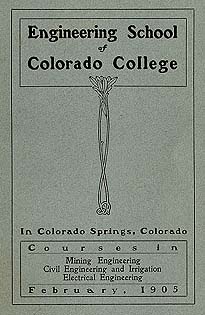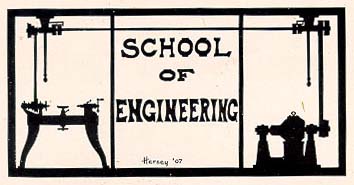Engineering School
 Located at the foot of Pikes Peak, Colorado College at the turn of the century was within easy distance of many mining, refining, and railway centers. The Cripple Creek District about 40 miles away was the site of numerous gold and silver mines. To service the mines, there were reduction plants in Colorado Springs, and of course, the railways all had facilities in town: the Colorado and Midland Railway, the Cripple Creek Short Line, and the Denver and Rio Grande. Within a slightly larger radius were Pueblo with a steel mill, Florence with reduction plants, Leadville with more mines, Idaho Springs with stamp mills (for crushing ore), and various sites with coal mines. The west was in desperate need of engineers and Colorado College was in a position to educate them.
Located at the foot of Pikes Peak, Colorado College at the turn of the century was within easy distance of many mining, refining, and railway centers. The Cripple Creek District about 40 miles away was the site of numerous gold and silver mines. To service the mines, there were reduction plants in Colorado Springs, and of course, the railways all had facilities in town: the Colorado and Midland Railway, the Cripple Creek Short Line, and the Denver and Rio Grande. Within a slightly larger radius were Pueblo with a steel mill, Florence with reduction plants, Leadville with more mines, Idaho Springs with stamp mills (for crushing ore), and various sites with coal mines. The west was in desperate need of engineers and Colorado College was in a position to educate them.
In 1903, Florian Cajori led the college in organizing a school of engineering and became its first dean. The prospectus for the new school began as follows:
This is recognized as the Age of the Engineer. His knowledge and skill are called for in almost every line of activity in human affairs. In winning coal and precious metals from the depths of the earth; in extracting them from the rock and refining them for use; in mining and smelting iron and other useful metals; in building railroads and bridges, in transporting men and merchandise; in erecting great buildings; in reclaiming vast territories of arid lands to make them fertile beyond the dreams of our forefathers; in harnessing the forces of nature to make them furnish power and light and heat; in all these, and other common lines of work, the engineer is the man who shows the way and on whom success depends.
The school offered courses in mining engineering, electrical engineering, and civil and irrigation engineering. Rather than "developing the memory by loading it with facts", the school promised to foster scientific habits of thought and work. The theoretical and experimental were thoroughly woven together. All this with Florian Cajori, the mathematician, at the helm and a new science building, Palmer Hall, nearing completion.
Gradually, the school lost its status at the college; the 1912 bulletin no longer listed engineering as a separate school. The curriculum continued under Cajori's direction, but when he left the college in 1918 no one replaced him as dean. This was a traumatic time for the college pushing engineering down the list of priorities. Yet the curriculum continued until it was officially discontinued when the college adopted a new plan in 1932 dividing the college into three divisions: School of Letters and Fine Arts, School of Social Sciences, and a School of Natural Sciences. Engineering Science with its mathematics requirements was still listed in the 1937 bulletin, but the emphasis had changed from degree work to pre-professional training. Students were encouraged to continue their degree work at more technical schools.
Rather than a failed experiment, the early Engineering School was a careful response by the college to the needs of the time. (Further interpretation is contained in John Fauvel's 1999 address on the occasion of Florian Cajori's birthday anniversary.)

Engineering maintains a continued presence at the college. In the 1960's there was an official department offering a short list of courses for prospective engineers: Graphics, Mechanics, Circuit Analysis, Surveying, Thermodynamics. By this time, the college had established a relationship with Rensselaer Polytechnic Institute allowing students from Colorado College to spend three years at the college followed by two years at the institute earning a bachelors or masters degree in engineering. Other institutions over the years have established similar relationships with the college.
In the 1960's, engineering professors Harold Polk and Ruth Kendrick often taught courses in the mathematics department. Professor Kendrick even held a joint appointment in both departments for a while. When Professor Polk retired in 1980, the engineering courses were phased out leaving only an advisor and the connection to other engineering schools.


